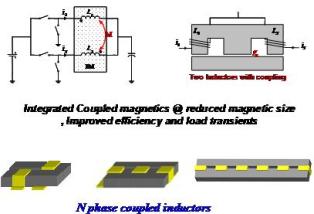LIBRARY
CPES Proposed Coupled Inductor (1998)

Today, every microprocessor is powered by a multi-phase voltage regulator (VR). Each phase employs a sizeable energy storage inductor to perform the necessary power conversion. For such an application, a larger inductance is preferred for steady-state operation, so that the current ripples can be reduced. On the other hand, a smaller inductor is preferred for fast transients, such as from "sleep-mode" to "wake-up mode" and vice versa. To satisfy this conflicting requirement, a nonlinear inductor, in principle, would be preferred so that during the steady state, the inductance value is large, while during the transient state, the inductance value is small. However, there is no simple way of realizing such a nonlinear inductor. In 1999, CPES proposed a coupled-inductor concept. When the inductors are coupled in a multi-phase buck converter, by virtue of magnetic coupling in the switching network, they behave like nonlinear inductors. The equivalent inductance is large for a steady state and small for a transient. This enables multi-phase VR to deliver power more effectively to the microprocessor that is currently operating at GHz clock frequency.
Shortly after this concept was proposed, it gained significant interest throughout industry as a method that could not only reduce magnetic size, but also improve the conversion efficiency and transient response, resulting in reduced footprint and cost. The picture below shows a two-phase coupled inductor, three-phase coupled inductor as well as a six-phase coupled inductor.






















































































